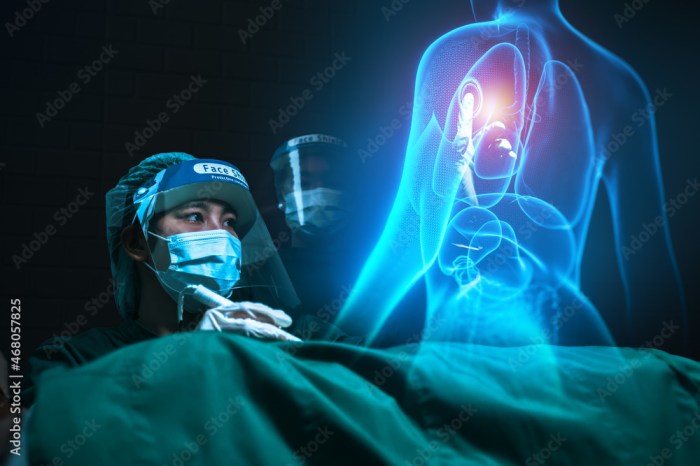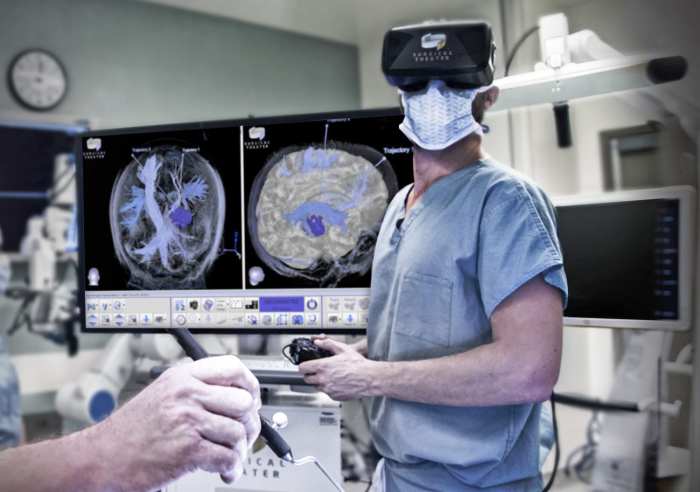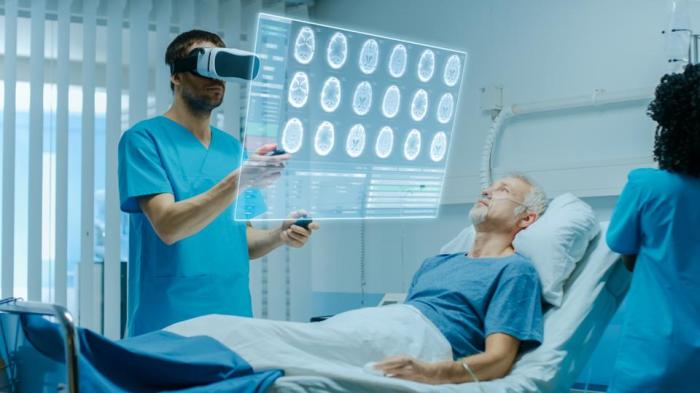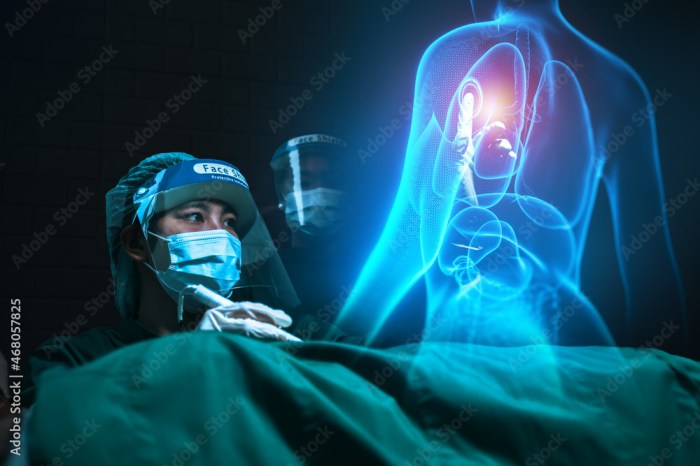
Holographic Patients: Training the Next Generation of Medics
Holographic patients to help train the next generation of medics – it sounds like something out of a sci-fi movie, but this technology is rapidly becoming a reality. The medical field is constantly evolving, and with it, the need for innovative training methods.
Traditional methods like cadavers and simulations have their limitations, but holographic patients offer a revolutionary solution. These lifelike projections can simulate a wide range of medical scenarios, providing students with a safe and immersive learning experience.
The technology behind holographic patients is complex, involving advanced computer graphics and projection systems. These systems create realistic 3D models of human anatomy, complete with intricate details and interactive elements. Students can interact with these holographic patients, performing procedures, diagnosing conditions, and even communicating with them, all in a virtual environment.
This level of immersion allows for a deeper understanding of medical concepts and a more confident approach to real-world patient care.
The Rise of Holographic Patients

The medical field is constantly evolving, driven by technological advancements that are transforming how we learn, diagnose, and treat diseases. One of the most exciting developments in medical training is the emergence of holographic patients. These lifelike, interactive simulations are revolutionizing how future doctors and nurses learn and practice their skills.Traditional training methods, while valuable, have limitations.
Cadavers, for example, offer a realistic anatomical experience, but they are expensive, require special facilities, and are limited in terms of dynamic interactions. Simulations, on the other hand, can be cost-effective and provide controlled environments, but they often lack the realism and complexity of real-life scenarios.
Holographic patients address these limitations by providing a unique combination of realism, interactivity, and affordability.
Holographic Patients: A New Era in Medical Training
Holographic patients are three-dimensional digital representations of human patients, created using advanced computer graphics and projection technology. These virtual patients can be customized to mimic a wide range of medical conditions, allowing trainees to experience a diverse range of clinical scenarios.
Imagine a future where medical students can practice their skills on holographic patients, experiencing realistic scenarios without any real-world risks. This innovative approach to training could revolutionize healthcare, but it requires a robust tech ecosystem. It’s a shame that Britain, once a leader in tech, has lost ground in recent years, as highlighted by the former CEO of ARM, who criticized the government for failing to retain its top tech firms.
We need to prioritize investment in innovation to ensure that the UK can develop and deploy cutting-edge technologies like holographic patients, which have the potential to transform healthcare for the better.
Here are some key benefits of holographic patients:
- Immersive and Realistic Experience: Holographic patients provide a highly immersive experience, allowing trainees to interact with virtual patients in a lifelike environment. They can observe physical characteristics, listen to patient narratives, and even perform virtual procedures, all within a safe and controlled setting.
- Customizable and Versatile: Holographic patients can be customized to represent various ages, genders, ethnicities, and medical conditions. This versatility allows trainees to practice their skills on a diverse range of patients, preparing them for real-world clinical encounters.
- Interactive and Responsive: Holographic patients can respond to trainees’ actions in real time, providing feedback and allowing for adjustments in treatment strategies. This interactivity creates a more dynamic and engaging learning experience.
- Cost-Effective and Accessible: Compared to traditional training methods, holographic patients offer a cost-effective and accessible solution. They can be used in multiple locations, eliminating the need for expensive cadavers or specialized simulation labs.
Examples of Holographic Patient Applications
Holographic patients are already being used in a variety of medical training programs, including:
- Surgical Training: Trainees can practice surgical procedures on holographic patients, gaining valuable experience in anatomical structures, surgical techniques, and instrument handling. For example, surgeons can practice laparoscopic surgery on holographic patients, receiving real-time feedback on their movements and surgical precision.
- Medical Diagnosis: Trainees can learn to diagnose various medical conditions by interacting with holographic patients who exhibit specific symptoms and signs. For example, a trainee can examine a holographic patient presenting with chest pain, listening to their heart sounds and reviewing their medical history to determine the potential cause.
- Patient Communication and Empathy: Holographic patients can be used to teach trainees how to communicate effectively with patients, demonstrating empathy and understanding. For example, a trainee can practice explaining a diagnosis or treatment plan to a holographic patient, receiving feedback on their communication style and emotional sensitivity.
Future of Holographic Patients
As technology continues to advance, holographic patients are expected to become even more sophisticated and realistic. Future developments may include:
- Artificial Intelligence Integration: Holographic patients could be integrated with artificial intelligence, allowing them to learn from past interactions and adapt their responses based on individual trainee behavior. This would create a more personalized and challenging learning experience.
- Enhanced Realism and Interactivity: Future holographic patients could incorporate advanced haptics technology, allowing trainees to feel the texture of tissues and organs during virtual procedures. This would further enhance the realism and immersion of the training experience.
- Remote Training and Collaboration: Holographic patients could be used for remote training, allowing trainees to connect with virtual patients and instructors from anywhere in the world. This would expand access to high-quality medical training and facilitate collaborative learning opportunities.
Technology Behind Holographic Patients

The rise of holographic patients in medical training is a fascinating development, promising to revolutionize how future doctors learn and practice. This technology leverages a combination of advanced principles and techniques to create realistic and interactive simulations of human anatomy and physiology.
Principles of Holographic Projection
Holographic projection, the core technology behind these simulations, is based on the principles of light interference and diffraction. It uses lasers to create a three-dimensional image that appears to float in mid-air. The process involves splitting a laser beam into two beams, one that illuminates the object and the other that serves as a reference beam.
The interference patterns created by these beams are then recorded on a holographic plate. When illuminated with a laser, the holographic plate recreates the original object in three dimensions.
Creating Realistic 3D Models
The creation of realistic 3D models of human anatomy is a complex process that involves multiple steps:* Scanning and Data Acquisition:Detailed anatomical scans are obtained using advanced imaging techniques such as CT scans, MRI scans, and ultrasound. These scans provide precise data on the structure and shape of organs, tissues, and bones.
Model Reconstruction
The acquired data is processed and used to create a digital 3D model of the human body. This model can be manipulated and viewed from different angles, allowing for a comprehensive understanding of anatomy.
Texturing and Detailing
The 3D model is then textured and detailed to create a realistic representation of the human body. This includes adding color, surface details, and other visual cues that contribute to a lifelike appearance.
Interactive Elements for Realistic Patient Interactions
To enhance the training experience, holographic patients are designed to be interactive, allowing future medics to engage in realistic scenarios. These interactive elements are made possible through:* Motion Tracking and Gesture Recognition:The holographic patient can respond to the trainee’s actions, such as palpating a virtual organ or performing a surgical procedure.
This is achieved using motion tracking technology that captures the trainee’s movements and translates them into real-time interactions within the holographic environment.
Artificial Intelligence (AI) Integration
AI algorithms are used to provide dynamic and responsive feedback to the trainee’s actions. For example, the holographic patient can exhibit symptoms based on the trainee’s examination or respond to treatment in a realistic way.
Haptic Feedback
In some cases, haptic feedback devices can be used to provide a sense of touch during interactions with the holographic patient. This can help trainees to develop their skills in areas like palpation and surgery.
Benefits of Holographic Patients for Medical Training

The advent of holographic patients represents a revolutionary leap forward in medical education, offering numerous advantages over traditional training methods. This technology creates immersive and interactive learning environments that enhance student understanding, improve clinical skills, and ultimately contribute to safer patient care.
Advantages over Traditional Methods
Holographic patients provide several key advantages over traditional training methods, such as cadavers, mannequins, and simulated patients.
- Enhanced Realism:Holographic patients offer a level of realism unmatched by traditional methods. Their lifelike appearance, movements, and responses create a more immersive and engaging learning experience for medical students. Unlike cadavers, which are static and lack physiological responses, holographic patients can simulate a wide range of medical conditions, including vital signs, anatomical structures, and physiological reactions.
This allows students to practice procedures and diagnoses in a more realistic setting, fostering a deeper understanding of the human body and disease processes.
- Cost-Effectiveness:Traditional training methods, particularly cadavers, are expensive to acquire and maintain. Holographic patients, on the other hand, offer a cost-effective alternative. They can be reused repeatedly without the need for costly replacements, making them a more sustainable and financially viable option for medical schools and training institutions.
- Accessibility:Holographic patients are readily accessible, eliminating the need for students to travel to specific locations or wait for limited cadaver availability. This accessibility allows for more frequent and flexible training sessions, ensuring that students can practice their skills consistently and efficiently.
This is particularly beneficial for remote or underserved areas where access to traditional training resources is limited.
- Safety and Ethical Considerations:Holographic patients address ethical concerns associated with using cadavers or live patients for training. Students can practice invasive procedures and interventions without risking harm to real individuals. The virtual nature of holographic patients allows for a safe and controlled environment where students can experiment and learn from their mistakes without consequences.
Immersive Learning Experience
Holographic patients provide an immersive learning experience that significantly enhances student engagement and knowledge retention.
Imagine a future where medical students can practice procedures on holographic patients, experiencing the complexities of human anatomy and disease in a safe, controlled environment. This innovative approach to training could revolutionize medical education, but it also highlights the need for global collaboration.
As the Europe’s economy survived terrible prophecies but must now tackle trade with China , fostering strong partnerships with countries like China will be crucial to developing and deploying such cutting-edge technologies, ultimately benefiting future generations of medical professionals.
- Interactive Learning:Holographic patients are interactive, allowing students to actively participate in the learning process. They can manipulate virtual organs, perform procedures, and receive immediate feedback on their actions. This interactive nature fosters a deeper understanding of anatomy, physiology, and clinical procedures.
- Personalized Learning:Holographic patients can be customized to simulate specific patient scenarios and conditions. This allows students to tailor their training to their individual needs and interests, providing a more personalized and effective learning experience. They can practice specific procedures or diagnoses relevant to their chosen specialty, enhancing their expertise in a targeted manner.
- Enhanced Engagement:The lifelike nature of holographic patients fosters a higher level of engagement and motivation among students. Their realistic appearance and responses make the learning process more engaging and memorable, contributing to improved knowledge retention and clinical skills development.
Improved Patient Safety, Holographic patients to help train the next generation of medics
By providing a safe and controlled environment for practice, holographic patients contribute significantly to improved patient safety.
- Reduced Medical Errors:Holographic patients allow students to practice procedures and diagnoses in a safe and controlled environment, minimizing the risk of errors that could potentially harm real patients. By simulating real-world scenarios, students can develop their clinical skills and decision-making abilities in a risk-free setting, reducing the likelihood of medical errors in actual clinical practice.
- Enhanced Confidence and Proficiency:The ability to practice procedures repeatedly in a safe and controlled environment builds student confidence and proficiency. This increased confidence translates into better clinical decision-making and improved patient outcomes. Students can practice procedures until they feel comfortable and competent, reducing the anxiety and hesitation that can lead to errors in real-world situations.
Imagine a future where medical students practice procedures on holographic patients, experiencing realistic scenarios without any real-life risks. This innovative approach to medical training is gaining traction, and it’s got me thinking about the ethical implications of using AI in other creative fields.
Just like the recent controversy surrounding the artist who used AI to win a fine arts competition, he used AI to win a fine arts competition was it cheating , we need to consider the boundaries of AI and human creativity in all aspects of life.
As holographic patients become more sophisticated, it’s crucial to ensure that we maintain the human element in healthcare education, focusing on empathy, communication, and ethical decision-making.
Applications of Holographic Patients in Medical Training: Holographic Patients To Help Train The Next Generation Of Medics
Holographic patients are revolutionizing medical training by offering a safe, realistic, and cost-effective way for future healthcare professionals to hone their skills in a variety of clinical scenarios. This technology allows for the creation of lifelike, interactive simulations that can be customized to replicate a wide range of medical conditions and patient presentations.
Applications of Holographic Patients in Medical Training
The applications of holographic patients in medical training are vast and extend across multiple medical specialties. Below is a table illustrating the potential of holographic patients in various fields:
| Medical Specialty | Scenario Examples | Skill Enhancement |
|---|---|---|
| Surgery | Practicing complex surgical procedures, such as laparoscopic surgery or open heart surgery. Simulating emergency situations like trauma surgery. | Improved surgical dexterity, spatial awareness, and decision-making skills in high-pressure environments. |
| Cardiology | Diagnosing and treating cardiovascular diseases, such as arrhythmias, heart attacks, and heart failure. Simulating procedures like angioplasty and stent placement. | Enhanced diagnostic abilities, improved understanding of cardiovascular physiology, and proficiency in performing cardiac interventions. |
| Emergency Medicine | Managing medical emergencies like trauma, cardiac arrest, and stroke. Simulating triage and patient assessment procedures. | Improved patient assessment skills, time management, and decision-making in emergency situations. |
| Psychiatry | Simulating patient interactions with mental health conditions, such as anxiety, depression, and schizophrenia. Practicing therapeutic techniques and communication skills. | Enhanced communication and interpersonal skills, understanding of mental health conditions, and development of empathy and therapeutic approaches. |
Ethical Considerations and Future Directions
The integration of holographic patients into medical training presents exciting possibilities for enhancing learning experiences. However, it also raises important ethical considerations that must be carefully addressed. This section delves into potential ethical concerns and explores the future potential of holographic patients, including advancements in technology and integration with other medical technologies.
Ethical Considerations
The use of holographic patients in medical training presents unique ethical considerations that need careful examination.
- Patient Privacy and Data Security:Holographic patients may be based on real patient data, raising concerns about patient privacy and data security. Strict protocols must be in place to ensure anonymization and secure storage of sensitive patient information.
- Emotional Impact on Students:The realistic nature of holographic patients could potentially have an emotional impact on students, particularly in scenarios involving simulated illness or trauma. Careful consideration should be given to the emotional well-being of students during training, and appropriate support systems should be available.
- Potential for Dehumanization:While holographic patients offer a valuable tool for training, it is crucial to ensure that they are not used in a way that dehumanizes patients. The training program should emphasize the importance of treating patients with empathy and respect, regardless of the training modality.
- Over-reliance on Technology:Holographic patients should not replace traditional clinical experiences. Students should still have opportunities to interact with real patients to develop essential communication and interpersonal skills.
Future Potential
The future of holographic patients in medical training is promising, with advancements in technology and integration with other medical technologies.
- Enhanced Realism:Advancements in holographic technology are likely to lead to even more realistic simulations, including improved anatomical detail, physiological responses, and interactive capabilities.
- Integration with Virtual Reality (VR) and Augmented Reality (AR):Holographic patients can be seamlessly integrated with VR and AR environments, providing immersive and interactive training experiences.
- Personalized Learning:Holographic patients can be customized to simulate specific patient conditions, allowing students to tailor their training to their individual learning needs.
- Remote Training:Holographic patients can facilitate remote training, enabling students to access high-quality medical education regardless of their location.

